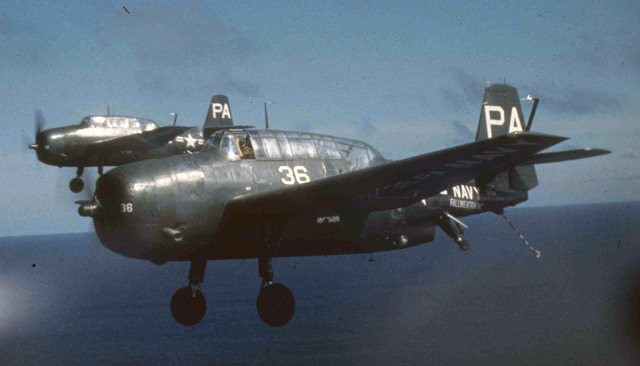The TBM-3E was the last production model, redesigned in detail to reduce weight and add provisions for an APS-4 radar pod under the starboard wing. The Eastern Aircraft Division of General Motors built 1,480 as the war was winding down and Navy contractors were completing the development of various single-engine attack airplanes like the AD Skyraider that would replace it and the Curtiss SB2C. The most obvious external difference was that the tailhook was stowed under the aft fuselage rather than within it.
The TBM-3Q was one of the first carrier-based airplanes configured specifically for electronic reconnaissance although it retained its ordnance-delivery capability so ELINT (short for electronic intelligence) was more of a collateral duty. It could also be used to "home-in" on enemy ships and shore-based defenses that utilized radar and jam the capability.
I found this picture of two "TBM-3Ns" on the excellent web site of the National Naval Aviation Museum (http://www.navalaviationmuseum.org/).
I thought that they were actually TBM-3Qs because they did not have turrets (according to one online description of the TBM-3Q, a characteristic of this conversion) and had ECM (Electronic Counter Measure) antennas identical to those on the Martin AM-1Q and the various Douglas Skyraider Qs.
I so informed the museum's library staff and got the immediate and polite response that to the best of their knowledge, the Ns did not have a turret and the Qs did. Another strike against online research.
The TBM-3N Radar Operator's position:
It appears that the TBM-3N was a postwar -3E modification to perform night and all-weather attack missions with updated electronic countermeasure avionics as a placeholder for the forthcoming Skyraider. Rick Morgan looked at some postwar location lists and estimates that no more than 30 conversions were accomplished. He found that some were assigned to the air groups linked with FDR (CVB-42) and Saipan (CVL-48) in early 1947 and early 1947/8 respectively. However most were operated by the night composite squadrons that provided detachments to deploying air groups, first VCN-1 and -2 and then their successors, VC-3 and -4. (For a brief summary of the role of composite squadrons, see http://thanlont.blogspot.com/2013/12/composite-squadrons-and-detachments.html.) TBM-3Ns were also operated by the two Fleet All-Weather Training Units, the Pacific (the two pictured above, circa 1950) and Atlantic
This is a picture from the files of the National Naval Aviation Museum of a VCN-2 TBM-3N landing on Philippine Sea in 1948.
Note the lack of a turret.
There was wartime precedence for the removal of the turret for night attack (and in fact, none of the Navy candidates for its postwar carrier-based attack requirements, day or night, had defensive armament). VT-90N removed the turret hardware (but not the enclosure) from its TBM-3D's in late 1944 or early 1945 to lighten them. If you look closely at the turret, you'll see that a crewman is sitting there, sans machine gun.
Note that the -3D was optimized for night attack with an APS-6 radar hard-mounted to the wing and various ECM antennas. Why was it not a -3N? Good question. For my attempt to unravel the World War II Navy airplane designation suffix history, see http://thanlont.blogspot.com/2014/03/navy-aircraft-designation-suffixes-redux.html and the links therein.
So what did the TBM-3Q look like? Larry Webster came up with this picture of one in an old Japanese aviation enthusiasts' magazine.
It has the aft-fuselage antennas like those on the TBM-3N but also retains the turret.
Rick Morgan was also exploring this question as well. His TBM-3Q post that resulted is far more detailed than the one I was coming up with. See http://rickmorganbooks.com/tbm-3q-avenger.html.
Your guess is as good as mine as to why the turret was retained on the -3Q. Mine is that there was a risk that the focus of its intention to collect electronic information for future strike-mission planning might take umbrage at the fact. As it turned out, several unarmed land-based "spy" planes were shot down during ELINT missions. For incidents involving the U.S. Navy, see https://www.nsa.gov/about/_files/cryptologic_heritage/publications/coldwar/dangerous_business.pdf
Rick Morgan opined that they retained the turrets because they were assigned to VT/VA squadrons that were primarily equipped with TBM-3Es that retained the turret. Since they could be assigned to day strikes along with the other Avengers in the squadron, their crews wouldn't want to be be defenseless in that event, much less likely to be singled out initially because of the lack of a turret.









1 comment:
I greatly appreciate this post on the little known "special mission" variants of the Avenger. This subject has long been of interest to me as my father's cousin, AMM3/c Richard J. Hall, flew as a "turret navigator" aboard specially configured TBM-3Ds with the pioneering Night Torpedo Squadron 90 (VT(N)-90) aboard the legendary USS Enterprise (CV-6) during World War Two. Sadly, he was lost during a daring night long range strike against the heavily defended port city of Kiirun, Formosa on 22 January 1945; however the unique and pioneering nature of his naval service has been of continuing effort to his family. Sadly there is little material available on the technical modifications incorporated into the early night attack TBM-3Ds, aside from the features noted in photographs such as the removal of defensive guns and the addition of flame dampeners on the exhausts.
Post a Comment